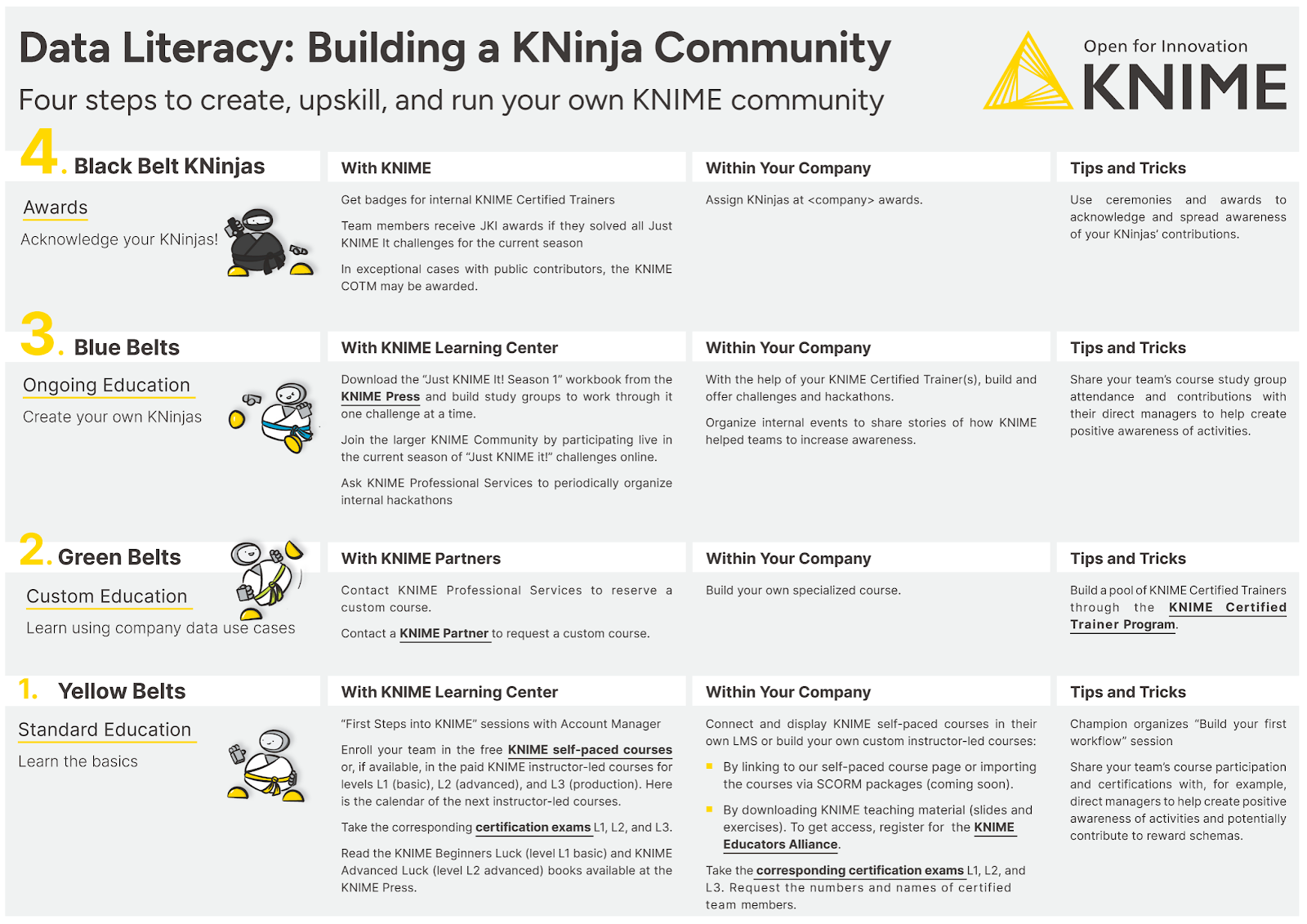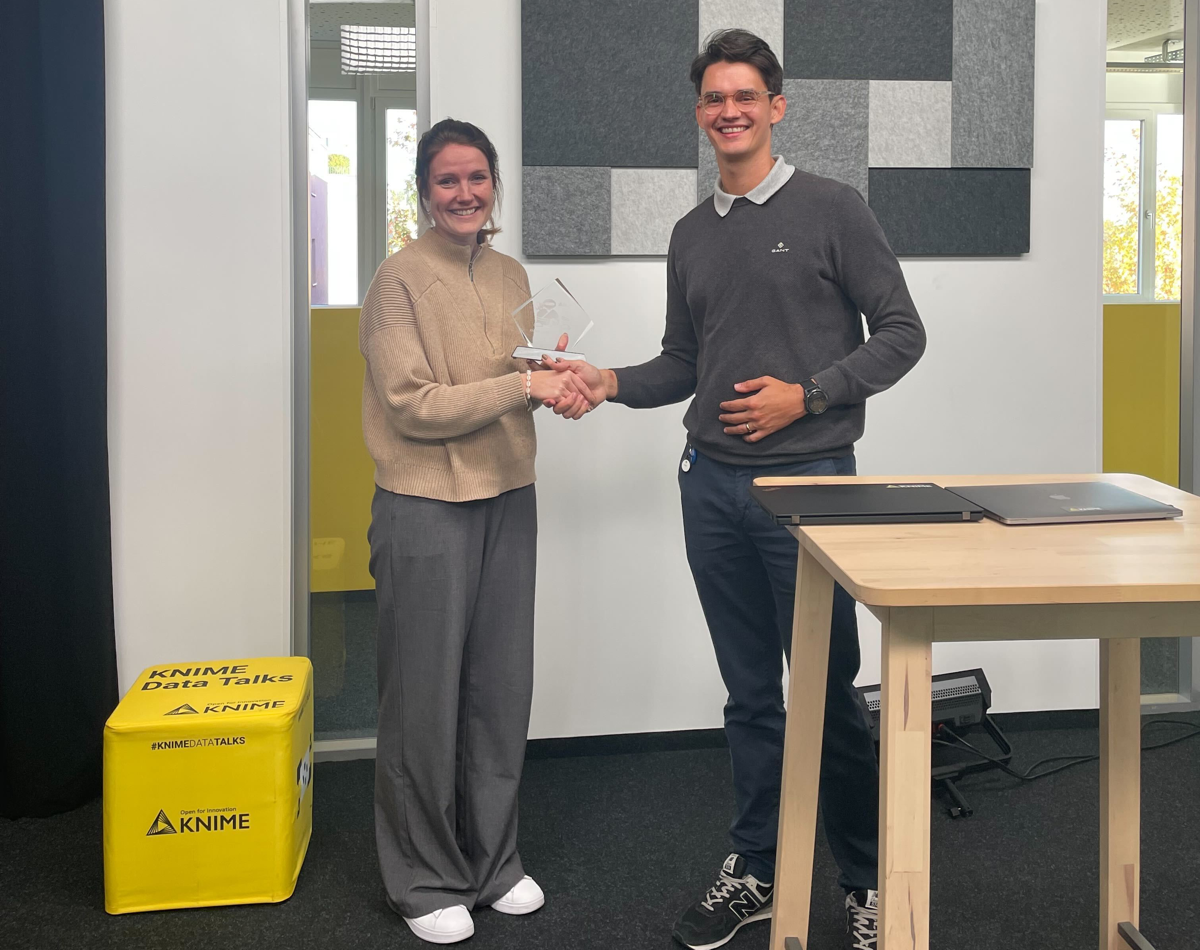The struggle we face in Human Resources is the nature of our data. It’s sensitive. It involves some of our employees' most personal information. Because of that, HR departments take every measure to minimize the risk of data privacy breaches. The disconnect between the different HR systems make this a complex task. Managing and processing this data independently with a tool designed to securely integrate, transform, and analyze data seems like an obvious solution. But HR professionals don’t always have the skills to work with the science techniques that make this possible.
My name is Gloria. I’m an HR Specialist at KNIME with a background in Business Engineering. Today, I am going to tell you how first our HR team and then almost the entire company upskilled to become data literate in under four months.
The problem: Our data is siloed in recruitment software, payroll platforms, learning management systems, and more. We have to use spreadsheets and email to collate, analyze, and distribute information. This involves many manual steps and time-consuming follow-up to ensure no data breaches.
The challenge: We need to upskill and learn data science techniques that will enable us to integrate data, automate repetitive, manual tasks, and minimize risk, but we all have different skills and levels of expertise. How can we create a scalable training program that would enable all business professionals to overcome any hesitations and learn data science?
The result: Data literate business professionals in 120 days. A lot of our work is repetitive and becomes interesting when it’s not repetitive anymore. Automating away the boring manual tasks has been very valuable to us.
Here’s how we did it.
Give everyone access to data analytics
Employees at KNIME have a wide range of skills and experience, from data experts who are either proficient Excel or BI tool users, to data scientists already working with data science tools like KNIME, Python, or R, but also domain experts – in our marketing, finance, HR, or sales teams, etc. Many of our domain experts consider themselves to be non-technical, without coding skills. It was a natural step for us to use KNIME Analytics Platform. The open source, visual workflows make analytics accessible to both technical and non-technical users.
Follow a program that supports analytics upskilling at scale
The goal to upskill teams to use data analytics with some kind of self-service approach makes sense, but it can be hard to know how to start. That’s certainly what we felt. Would we need a year-long university course, or could we find a quicker solution? How could I motivate my colleagues? How difficult was it going to be? Could this upskilling be achieved within a reasonable time? How long would it take? Who could guide us as mentors?
We needed a scalable approach that would be accessible and effective for non-technical professionals.
We followed KNIME’s Community Manifesto for Data Literacy. It sets out a 4-step plan that any company can use to build teams of data literate experts i.e., a community of KNinjas!

Step 1: Learn the basics and earn a yellow belt
At a company-wide call, we asked everyone to take part in the data literacy upskilling challenge. The goal was to get as many KNIMErs as we could to take as many certification exams in data science with KNIME as possible within 90 days.
KNIMErs were asked to download KNIME and explore the KNIME Learning Center to sign up for self-paced (free) or instructor-led courses (subject to a fee).
- These courses cater not just to beginners (L1 basic) and advanced users (L2 advanced / L3 production) but also to individuals who want to specialize their data skills (L4 specialization).
→ Note: Check out these additional learning resources to help people along their learning journey:
- KNIME Press books: Resources like KNIME Beginners Luck (L1) and KNIME Advanced Luck (L2) provide an excellent starting point.
- KNIME Press cheat sheets: For a quick reference, KNIME offers cheat sheets that make it easy to grasp the basics.
→ Tip: You can request a “First Steps into KNIME” session with KNIME by emailing support@knime.com. They guide you through the KNIME Learning Center explaining various educational options to set you on the right track.
Foster commitment with the 90-day certification challenge
The biggest challenge during this stage is to foster commitment. While enthusiasm is high at the beginning, training courses and certification exams in the midst of everyday work can be hard to handle.
Running the certification challenge turned the “task” of learning into a more fun activity, with each team at KNIME competing to see which team could get the most certifications.
- 96% achieved the L1 certification
- 35% of the company earned L2 certification
- 23% reached the L3 level
- A few even completed some L4 specializations
Use incentives to maintain motivation
Starting a new educational path can feel challenging, especially with time or energy constraints. To recognize everyone’s efforts and maintain motivation we:
- Celebrated KNIMErs and teams who achieved the highest number of KNIME certifications with awards.
- Documented completed courses and certifications in each employee HR profile to track the success.
- Offered incentives to those who completed the educational paths and got at least one certification. This was highly effective in encouraging the team.
Step 1 takeaways: With at least one certification held by each member of a team, we completed the first step “Standard Education” and set a solid foundation for future learning.
Step 2: Continue learning with real business problems and earn your green belts
At this step, it’s time to apply what you’ve learned to real business problems and data.
- You might consider offering your teams customized courses led by a business expert— such as a KNIME Partner, a KNIME certified trainer, or an internal teacher.
- Find partner trainers, trainers at customers, and community trainers on the Certified Trainers webpage.
→ Tip: Identify and support your KNIME Certified Trainer(s). This is often when someone in the group naturally steps up as the driving force for learning. For example: somebody with a strong interest in the data, who is ahead on the learning curve, and/or interested in going one step further in building the community. Look for this person, encourage them to become your team’s champion, and consider placing them on the KNIME certified trainer program. They can help lead and inspire others on their data journey.
In our group, I took on this role. I created some initial examples analyzing our HR data, which encouraged my colleagues to develop more solutions independently.
Step 2 takeaways: Building real applications on real data completes step 2 “Custom Education” and earns your team a Green Belt. This step builds the team’s confidence in applying data insights to real-world scenarios.
Step 3: Practice makes perfect with fun challenges to earn the team’s blue belt
Courses are easily attended and immediately forgotten. The third step is devoted to practicing hands-on, in groups, and adding a fun factor.
- KNIME offers a series of challenges during the year called Just KNIME it!. A new challenge is released every Wednesday with solutions due the following Tuesday. The challenges vary in difficulty, ranging from easy to intermediate, and help participants build their data skills progressively.
- If you start your own upskilling journey at a time when the Just KNIME It! Challenge isn’t running, you can read about previous seasons in the books, Just KNIME It! – season 1 and season 2.
- We started with the easy problems in the Just KNIME It! - season 1 book and later tackled the intermediate-level challenges.
→ Tip: Weekly group meetings. Working in a group reduces stress and makes the whole experience more positive. In addition, it allows everyone to learn from each other’s insights and ideas. We held weekly meetings to discuss our solutions.
It was inspiring to see how many different ways there were to reach a solution to the same problem. The weekly meeting was a good opportunity to ask questions. More advanced learners gave help, while colleagues from our customer care team provided us with insight into all kinds of different use cases. It was great to learn what’s possible.
Step 3 takeaways: Completing this stage gets you with a Blue Belt and ensures your skills are well-practiced and reinforced.
Step 4: Earning the black belt and becoming a KNinja
The last step to become a fully data-driven team is to recognize the hard work of your top people, who have been driving the journey.
- The “Black Belt KNinja” title is reserved for those who not only excel in data literacy but also lead the way for others.
- In our journey, we started with self-paced courses and certifications, progressed to analyzing our own data, and maintained our skills through collaborative practice with “Just KNIME It!” challenges.
Step 4 takeaways: At the end of this step you will have multiple upskilling leaders making data literacy pervasive across your organization.

The data science upskilling flywheel
The easier it was for our teams to access data science solution starters, training resources, and best practices, the easier it was for us to upskill. Momentum grew with each piece of knowledge shared and we were able to connect and learn from one another. This effect was amplified with each new app or service we built that delivered data insight across the company.
Start data science upskilling at scale and lay the foundation for a competitive (AI ready) future.
